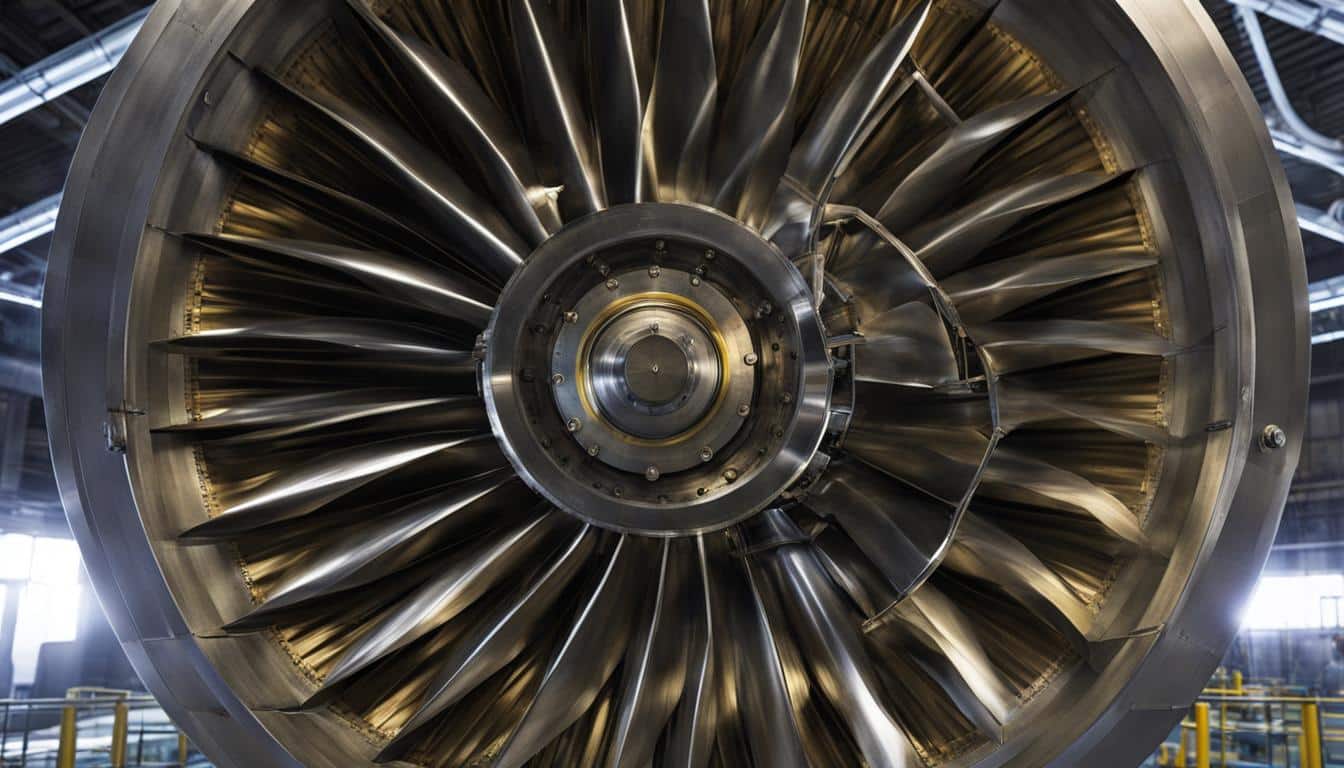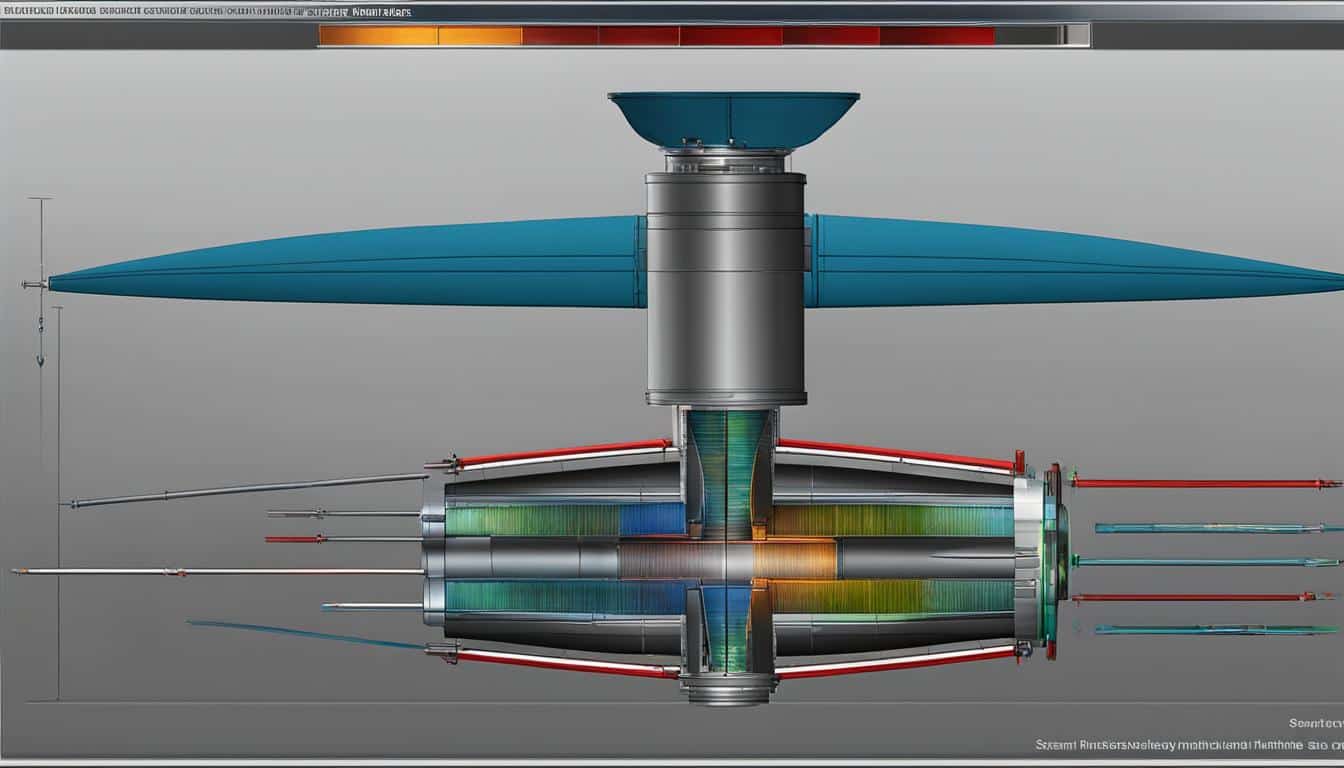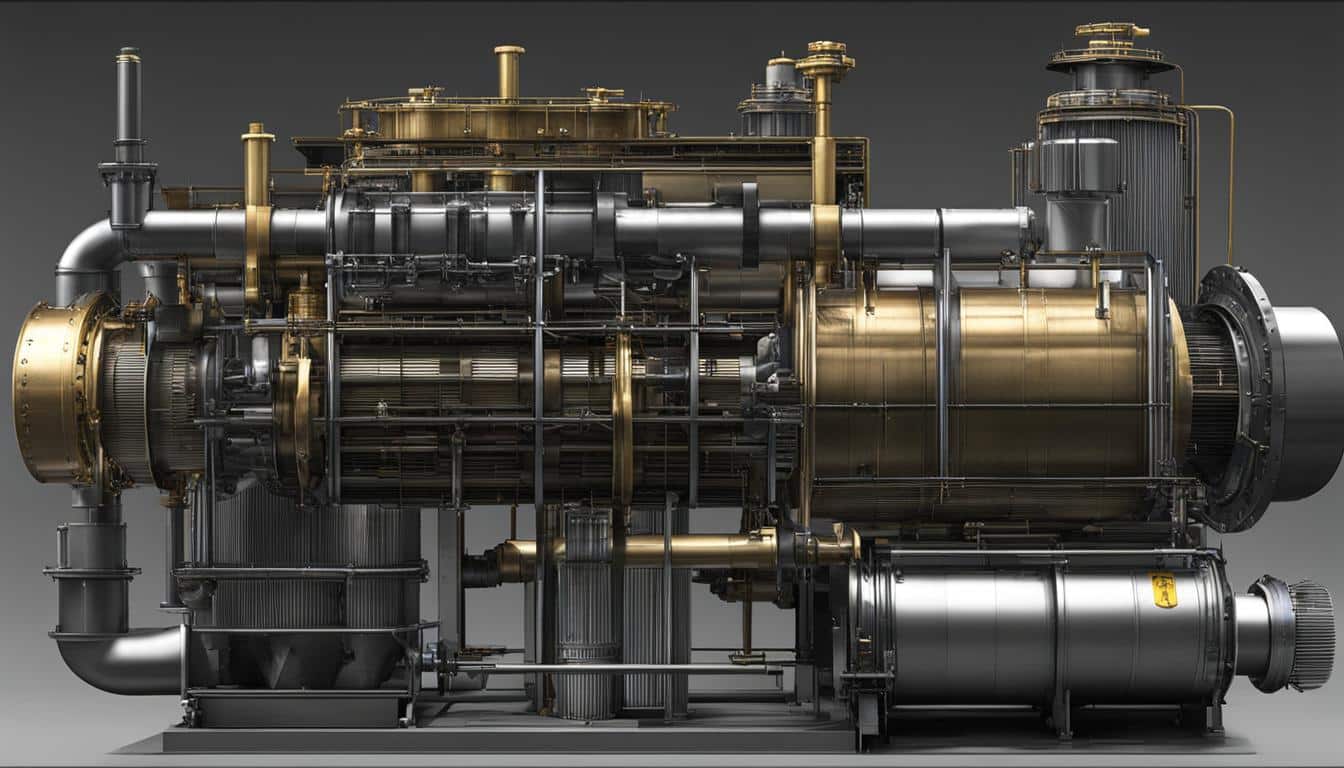Exploring Types of Steam Turbines
Steam turbines play a crucial role in power generation, industrial processes, and marine propulsion systems. They harness the thermal energy of pressurized steam and convert it into mechanical energy. This reliable and efficient energy production method is widely used across various industries.
When it comes to modern steam turbines, there are three basic types of steam machines available, each with its own design and application. In this guide, we will explore the various types of steam turbines and their usage in different industries and processes.
Key Takeaways
- Steam turbines are essential for power generation, industrial processes, and marine propulsion systems.
- They convert thermal energy from pressurized steam into mechanical energy.
- There are several types of steam turbines, including impulse turbines, reaction turbines, condensing turbines, extraction turbines, backpressure turbines, and reheat turbines.
- Each type is designed for specific applications and power requirements.
- Understanding the characteristics of each type is crucial for selecting the right steam turbine for efficient energy production.
Impulse Turbine
In small-scale applications, such as power plants with capacities up to a few megawatts, the impulse turbine is a popular choice. This type of turbine operates by harnessing the power of high-velocity jets of steam, which are directed onto turbine blades. As the steam expands through a series of nozzles, it impacts the blades, causing them to rotate and generate mechanical energy.
Impulse turbines are designed to efficiently convert the energy of steam jets into rotational motion. The high-velocity steam creates a force that propels the blades, enabling the turbine to generate power. Due to their compact size and ability to efficiently utilize high-velocity steam, impulse turbines are well-suited for small-scale applications where space is limited and a reliable source of steam is available.
Impulse turbines are commonly used in small-scale power plants, where they provide an efficient and cost-effective means of generating electricity. These turbines play a crucial role in small-scale applications that require reliable and efficient power generation.
| Advantages | Disadvantages |
|---|---|
|
|
Despite their limitations, impulse turbines continue to play a crucial role in small-scale power generation. Their ability to efficiently harness and convert the energy of high-velocity steam jets makes them an ideal choice for applications where space is limited and a steady supply of steam is available.
Reaction Turbine
A reaction turbine is a key component in large-scale power plants, where it efficiently harnesses the power of high steam flow rates and stream pressures. This type of turbine features both fixed and moving blades, which play a crucial role in its operation.
The fixed blades are stationary and serve to guide the steam as it passes through the turbine. They are strategically positioned to ensure a continuous and controlled expansion of the steam. On the other hand, the moving blades are arranged in a rotating rotor. As the steam flows over these blades, it causes a reaction that imparts rotational motion to the rotor. This rotation is then utilized to generate mechanical energy, which can be converted into electricity.
If you’re looking for rotor repair, check out our industry-leading services!
The continuous expansion of steam through the reaction turbine blades allows for optimal energy transfer, resulting in high efficiency. This makes reaction turbines particularly well-suited for large-scale power plants that demand sustainable and efficient energy production.

| Turbine Type | Main Features | Applications |
|---|---|---|
| Impulse Turbine | High-velocity steam jets | Small-scale applications |
| Reaction Turbine | Fixed and moving blades | Large-scale power plants |
| Condensing Turbine | Operates under vacuum conditions | Power plants with waste heat recovery |
| Extraction Turbine | Multiple extraction points | Industrial processes, heating applications |
| Backpressure Turbine | Generates electricity and provides process steam | Combined heat and power systems |
| Reheat Turbine | Incorporates reheating for improved efficiency | Large power plants |
Condensing Turbine
A condensing turbine is a type of steam turbine designed to operate under vacuum conditions. Its purpose is to maximize the pressure drop across the turbine, thereby improving efficiency. Condensing turbines are commonly used in power plants where waste heat recovery is desired.
After the steam passes through the turbine, it enters a condenser where it is condensed back into water. This condenser operates under vacuum conditions, creating an environment in which the pressure drop can be maximized. By lowering the steam pressure, the turbine can extract more energy from the steam, resulting in improved efficiency.
The condenser plays a critical role in the operation of a condensing turbine. It is responsible for removing heat from the steam and converting it back into water. This condensed water can then be recycled and used again in the steam cycle, reducing water consumption and optimizing energy utilization.
In power plants, condensing turbines are often integrated with waste heat recovery systems. These systems allow the plant to capture and utilize the excess heat generated during power generation for other purposes, such as district heating or industrial processes. This improves overall energy efficiency and minimizes waste.
By harnessing vacuum conditions and maximizing pressure drop, condensing turbines play a vital role in improving the efficiency of power plants and facilitating waste heat recovery. They enable the generation of electricity while making the most of available resources, making them essential components in modern energy production.
Extraction Turbine
An extraction turbine plays a crucial role in various industrial processes by extracting steam at intermediate pressures. It is specifically designed with multiple extraction points, allowing steam to be tapped at specific pressure levels for heating, feedwater heating, and other industrial applications.
These turbines are commonly used in industries such as pulp and paper, sugar production, chemical processing, and district heating. They enable efficient extraction of steam at intermediate pressures to meet the diverse heating and process requirements of these industries.
The extraction turbine’s ability to provide intermediate pressure steam makes it an ideal choice for feedwater heating, where the extracted steam heats the feedwater before entering the boiler. This process improves overall thermal efficiency, reducing energy consumption and costs.
Another notable application of extraction turbines is in the pulp and paper industry, where steam is extracted at different pressures to power various processes involved in paper manufacturing. This includes the drying process, where steam is utilized to remove moisture from the paper sheets.
In the sugar industry, extraction turbines are used to generate power while extracting steam for heating and processes involved in sugar production. These turbines play a vital role in enhancing energy efficiency and reducing reliance on external energy sources.
Chemical processing plants also benefit from extraction turbines as they provide steam at intermediate pressures required for various chemical reactions and heat transfer processes. The versatility of these turbines makes them essential for optimizing energy usage and maintaining the operational efficiency of chemical plants.
District heating systems, which supply heat to multiple buildings or communities, greatly rely on extraction turbines for efficient steam extraction at intermediate pressures. This enables cost-effective and environmentally friendly heat provision for residential, commercial, and industrial purposes.

With their ability to extract steam at intermediate pressures for diverse industrial processes, extraction turbines play a vital role in improving energy efficiency, reducing costs, and supporting sustainable development across various sectors.
Backpressure Turbine
A backpressure turbine is a versatile device that serves multiple purposes in energy production and industrial applications. These turbines play a crucial role in electricity generation while also providing valuable process steam at lower pressures. This section explores the key aspects of backpressure turbines and their applications in combined heat and power systems, industrial processes, and heating applications.
Backpressure turbines are specifically designed to efficiently produce electricity while simultaneously generating process steam. The exhaust steam released from the turbine at a certain pressure and temperature can be utilized for various industrial processes, such as heating applications.
Combined heat and power (CHP) systems leverage the benefits of backpressure turbines by generating both electricity and heat simultaneously. This integrated approach maximizes energy efficiency, reduces overall energy consumption, and minimizes environmental impact.
In industrial processes, backpressure turbines are widely employed to meet the demand for electricity while harnessing the valuable exhaust steam for heating requirements. This dual-purpose operation significantly improves the overall energy efficiency of the industrial facilities.
Additionally, backpressure turbines find applications in district heating systems, where they efficiently produce both electrical power and process steam for supplying heat to residential, commercial, and institutional buildings. The versatility of backpressure turbines makes them invaluable in various settings.
Reheat Turbine
In large power plants, reheat turbines are commonly used to enhance the efficiency of the steam cycle. These turbines play a crucial role in improving the overall performance of the power plant by maximizing the utilization of steam energy.
The operation of a reheat turbine involves two main sections: the high-pressure section and the low-pressure section. In the high-pressure section, steam is initially expanded to generate mechanical energy. The steam is then reheated before entering the low-pressure section, where it undergoes further expansion.
The process of reheating the steam offers several advantages. It helps maintain the energy level of the steam during expansion, resulting in improved overall efficiency. By reheating the steam, its temperature and pressure are raised before it enters the low-pressure section, allowing for additional work extraction. This leads to better utilization of the steam’s energy and enhances the output of the turbine.
Reheat turbines are particularly suitable for large power plants where maximizing efficiency is a priority. These turbines contribute to the improved conversion of thermal energy into mechanical energy, thereby enhancing the performance and output of the power plant.
Table: Comparison of Steam Turbine Types
| Turbine Type | Main Characteristics | Applications |
|---|---|---|
| Impulse Turbine | Steam jets onto turbine blades | Small-scale applications |
| Reaction Turbine | Fixed and moving blades for continuous expansion | Large-scale power plants |
| Condensing Turbine | Operates under vacuum conditions with a condenser | Power plants, waste heat recovery |
| Extraction Turbine | Steam extraction for various industrial processes | Pulp and paper, sugar, chemical processing |
| Backpressure Turbine | Electricity generation and process steam | Combined heat and power systems |
| Reheat Turbine | Steam reheating for improved efficiency | Large power plants |
Conclusion
Steam turbines play a vital role in power generation and industrial processes, harnessing the mechanical energy derived from the thermal energy of steam. With various types available, including impulse turbines, reaction turbines, condensing turbines, extraction turbines, backpressure turbines, and reheat turbines, it is crucial to understand their individual characteristics and applications to ensure efficient energy production.
For power generation, steam turbines are used to drive electric generators, providing electricity for homes, businesses, and industries. In industrial processes, steam turbines are employed to power pumps, compressors, and other rotating equipment necessary for various manufacturing operations.
When selecting a steam turbine, factors such as power requirements, pressure, temperature conditions, and overall efficiency must be taken into account. By choosing the appropriate turbine type, companies can optimize their energy production and maximize efficiency, ultimately contributing to sustainable and cost-effective operations.
In conclusion, steam turbines are indispensable components for power generation and industrial processes, converting steam’s thermal energy into valuable mechanical energy. With their versatile applications, steam turbines play a crucial role in driving progress and providing efficient energy solutions for a wide range of industries.
FAQ
What are steam turbines used for?
Steam turbines are widely used in power generation, industrial processes, and marine propulsion systems. They convert the thermal energy of pressurized steam into mechanical energy, which can drive electric generators, pumps, compressors, or other rotating equipment.
How many types of steam turbines are there?
There are several types of steam turbines, including impulse turbines, reaction turbines, condensing turbines, extraction turbines, backpressure turbines, and reheat turbines.
How does an impulse turbine work?
An impulse turbine operates by directing high-velocity steam jets onto turbine blades. The steam expands through a series of nozzles and impacts the blades, causing rotation.
What is a reaction turbine?
A reaction turbine consists of both fixed and moving blades. The steam expands as it passes through these blades, resulting in a continuous expansion and increased efficiency.
What is a condensing turbine?
A condensing turbine is designed to operate under vacuum conditions. After the steam passes through the turbine, it enters a condenser where it is condensed back into water. The vacuum in the condenser helps maximize the pressure drop across the turbine, improving efficiency.
What is an extraction turbine used for?
An extraction turbine is designed to extract steam at intermediate pressures for various industrial processes. It has multiple extraction points where steam can be tapped at specific pressure levels for heating, feedwater heating, or other industrial processes.
What is a backpressure turbine?
A backpressure turbine is primarily used for generating electricity while providing process steam at a lower pressure. The exhaust steam from the turbine is released at a certain pressure and temperature, which can be used for industrial processes or heating applications.
What is a reheat turbine?
A reheat turbine is commonly used in large power plants to improve the efficiency of the steam cycle. The steam is first expanded through the high-pressure section, then reheated and expanded further through the low-pressure section. Reheating the steam helps maintain its high energy level during expansion, resulting in improved overall efficiency.
Why are steam turbines important?
Steam turbines are essential components in power generation and industrial processes, converting the thermal energy of steam into mechanical energy. They play a vital role in efficient energy production and are used in various applications to drive machinery and equipment.

